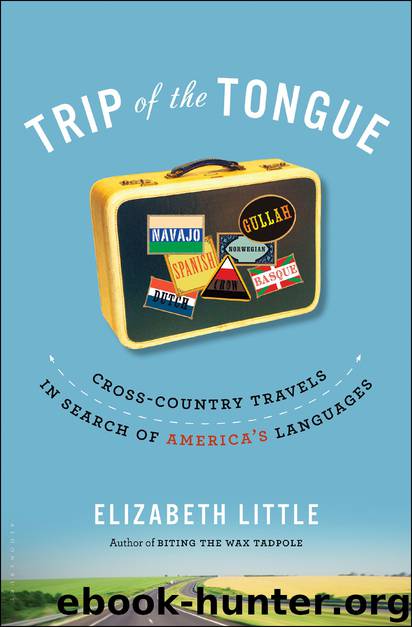Trip of the Tongue by Elizabeth Little

Author:Elizabeth Little
Language: eng
Format: epub
Publisher: Bloomsbury USA
Chapter Six
Nevada: Basque
At the same time that African languages were mixing and melding with French, English, and other languages of the American South, the languages of Europe were extending into the farthest reaches of the country. Between 1820 and 1924, nearly 36 million immigrants came to the United States, first from the United Kingdom and northwest Europe and later from eastern Europe and the Mediterranean. They streamed into the ports of Boston, Baltimore, and New York, making their way by train, by horse, or by foot to destinations throughout the United States. Some of these immigrants made their homes in the nation’s cities, settling the neighborhoods that decades later would contribute so much to regional character. There were Poles in Chicago and Hungarians in Cleveland, Greeks in Detroit and Italians in Providence, Russians in Baltimore and Irish in Boston.
Other groups chose to venture out into the great expanse of the American West. These men and women were driven by economic concerns as surely as were the factory workers of the Northeast, drawn not to the garment or automobile factories but to the cheap, plentiful land available to anyone willing to work it. Soon there were Finns in upper Michigan and Czechs in central Kansas; there were Swedes in northern Minnesota and Portuguese in southern Illinois.
And then there were the Germans, who were just about everywhere.
For years, these rural communities and their languages were largely cut off from the rest of America. These immigrants built schools, held religious services, ran businesses, and established local newspapers, all in their native languages. But over time, the same economic forces that attracted so many immigrants from so many corners of the world reduced these language communities to whispers of their former selves.
I’ve spent years of my life in cities with rich histories of immigration. I’d been to Little Italys and Little Tokyos and Little Indias and Little Seouls. I knew what ethnic neighborhoods and enclaves looked like; I knew what they sounded like. But I didn’t have the slightest clue about their rural counterparts. Why hadn’t they been able to maintain their language and traditions? What were the particular challenges that they faced? Were there any traces of linguistic heritage still to be found? I decided to find out.
I pulled out my ratty old road atlas and flipped to the big square states. I needed to pick wisely. Though the languages of nineteenth-century immigrants are, on the whole, far more familiar to me than Navajo or Makah, I knew that on this side of the ocean, these languages live on less in conversation than they do in the everyday rituals of American ethnicity. I didn’t want to drive eighteen hours to a town whose only lingering ties to the motherland were souvenir shirts that read “Kiss me, I’m One Thirty-Second Slovakian.”
To avoid this, I decided to structure this portion of my trip around the loudest, busiest, and most accessible ethnic ritual of all: the big, boozy festival. I figured there was no better way to get to know America’s immigrant communities than to party with them.
Download
This site does not store any files on its server. We only index and link to content provided by other sites. Please contact the content providers to delete copyright contents if any and email us, we'll remove relevant links or contents immediately.
Cecilia; Or, Memoirs of an Heiress — Volume 1 by Fanny Burney(32434)
Cecilia; Or, Memoirs of an Heiress — Volume 2 by Fanny Burney(31871)
Cecilia; Or, Memoirs of an Heiress — Volume 3 by Fanny Burney(31854)
The Lost Art of Listening by Michael P. Nichols(7406)
Asking the Right Questions: A Guide to Critical Thinking by M. Neil Browne & Stuart M. Keeley(5635)
We Need to Talk by Celeste Headlee(5544)
On Writing A Memoir of the Craft by Stephen King(4863)
Dialogue by Robert McKee(4321)
Pre-Suasion: A Revolutionary Way to Influence and Persuade by Robert Cialdini(4150)
I Have Something to Say: Mastering the Art of Public Speaking in an Age of Disconnection by John Bowe(3840)
Elements of Style 2017 by Richard De A'Morelli(3307)
The Book of Human Emotions by Tiffany Watt Smith(3238)
Fluent Forever: How to Learn Any Language Fast and Never Forget It by Gabriel Wyner(3028)
Name Book, The: Over 10,000 Names--Their Meanings, Origins, and Spiritual Significance by Astoria Dorothy(2939)
Good Humor, Bad Taste: A Sociology of the Joke by Kuipers Giselinde(2903)
Why I Write by George Orwell(2874)
The Art Of Deception by Kevin Mitnick(2736)
The Grammaring Guide to English Grammar with Exercises by Péter Simon(2710)
Ancient Worlds by Michael Scott(2625)
